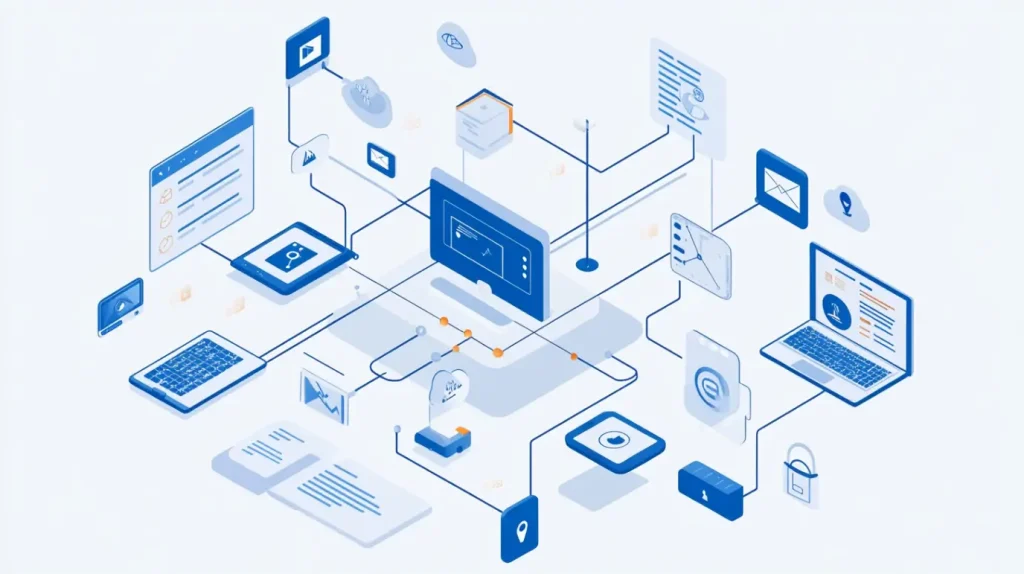Do you ever look at your data and feel like you’re only seeing small, disconnected pieces of a larger puzzle? You might see how many people visit your website, how many “like” your social media posts, and how many sales you make, but connecting those dots can feel impossible. This is where end-to-end analytics comes in.
This guide will simply explain what end-to-end analytics is, why it’s a game-changer, and the types of tools that help you see the complete customer journey from start to finish.
The Problem with ‘Siloed’ Data
Most businesses start by looking at data in “silos”. This means the data from each tool is separate and doesn’t talk to the others.
- Your social media analytics are in one place.
- Your website traffic data is in another.
- Your sales or lead information is in a completely different system (like a CRM or e-commerce platform).
Example of the Problem: Your marketing team runs a successful social media campaign that gets thousands of likes and shares. They report great engagement. But the sales team doesn’t see a corresponding increase in new customers. Without a connected view, you can’t tell if the campaign actually contributed to your business goals or just generated temporary buzz.
The Power of End-to-End Analytics: Seeing the Whole Journey
End-to-end analytics is the process of connecting data from multiple sources to track a user’s entire journey with your brand. The goal is to tell a complete story.
Example of the Solution: With a connected analytics setup, you can see the full story of a new customer:
- First Touch: They first discovered your brand by reading a blog post they found on Google.
- Nurturing: A week later, they saw one of your ads on social media and followed your page.
- Consideration: They received a few of your email newsletters.
- Conversion: Two weeks later, they clicked a link in an email, returned to your site, and made a purchase.
Now you know that your blog (SEO), social media ads, and email marketing all played a role in acquiring that customer. This insight is incredibly powerful for deciding where to invest your time and money.
Key Categories of End-to-End Analytics Tools
Building an end-to-end view doesn’t mean finding one single magic tool. It means using different types of tools for each stage of the journey and, ideally, connecting them.
1. Traffic & Acquisition Tools: “Where do users come from?”
- Purpose: To understand your traffic sources.
- Tool Types:
- Web Analytics Platforms: These are the foundation (e.g., Google Analytics 4). They show you how many people visit your site and how they got there (organic search, social media, paid ads, direct links).
- SEO Tools: These help you understand and improve your visibility in search engines (e.g., Ahrefs, SEMrush).
- Ad Platform Analytics: Each ad platform (Google Ads, Facebook Ads, etc.) has its own analytics to track ad performance.
- Example: You use these tools to discover that while paid ads bring in a lot of visitors, the visitors who come from organic search (Google) spend more time on your site and are more likely to become customers.
2. On-Site Behavior Tools: “What do users do here?”
- Purpose: To understand how users interact with your website.
- Tool Types:
- Heatmapping Tools: These create visual representations of where users click, move their mouse, and scroll.
- Session Recording Tools: These allow you to watch anonymized recordings of real user sessions on your site.
- Example: You watch a session recording and see that multiple users are trying to click on an image that isn’t actually a link. This shows you a point of user frustration that you can now fix.
3. Conversion & Business Tools: “Did they complete the goal?”
- Purpose: To track the final, desired actions and manage customer relationships.
- Tool Types:
- CRM (Customer Relationship Management) Systems: These store all information about your leads and customers, including their contact info and interaction history.
- E-commerce Platform Analytics: If you run a store, your platform has built-in analytics to track sales, products, and revenue.
- Example: Your CRM data shows that leads who attended your recent webinar are converting into customers at a much higher rate than other leads.
4. Integration & BI Tools: “How do we connect everything?”
- Purpose: This is the “glue” that holds your end-to-end strategy together.
- Tool Types:
- Integration Platforms (Middleware): Services that help different apps “talk” to each other without needing custom code (e.g., Zapier, Make).
- Business Intelligence (BI) Tools: These powerful platforms can pull data from all your different sources (your CRM, ad platforms, web analytics) into a single dashboard for deep analysis.
- Example: You use an integration platform to automatically send every new lead from your website’s contact form directly into your CRM. You then use a BI tool to create a dashboard that shows your total ad spend next to the actual revenue generated from those customers, giving you a true Return on Investment (ROI) calculation.
Putting It Into Practice: A Simple Workflow
- Map the Journey: Whiteboard the typical steps a customer takes, from awareness to purchase.
- Collect Data: Identify which tools you can use to gather data at each step.
- Connect the Dots: Start with a simple integration. For example, connect your website forms to your email marketing software or CRM.
- Analyze and Act: Look for patterns. Where are people dropping off? Which channels bring in the most valuable customers? Use these insights to make improvements.
Conclusion: From Disconnected Data to a Clear Story
End-to-end analytics is about transforming your approach from looking at isolated metrics to understanding the complete story of your customers. It allows you to make smarter, data-driven decisions about where to focus your efforts. You don’t need to implement everything at once. Start by connecting two of your most important tools and begin building a more complete picture of what truly drives your growth.



